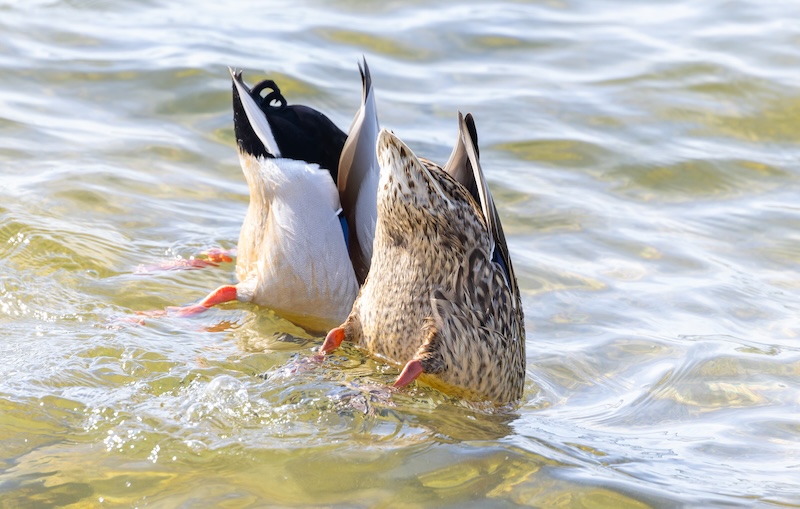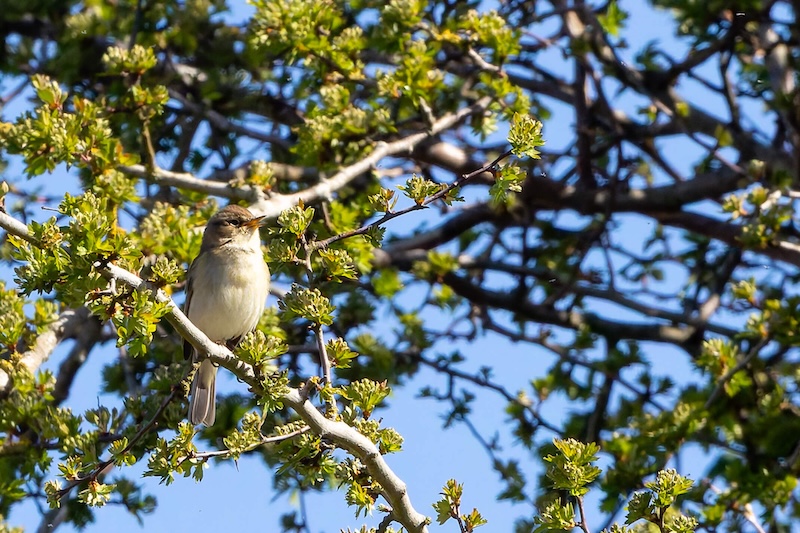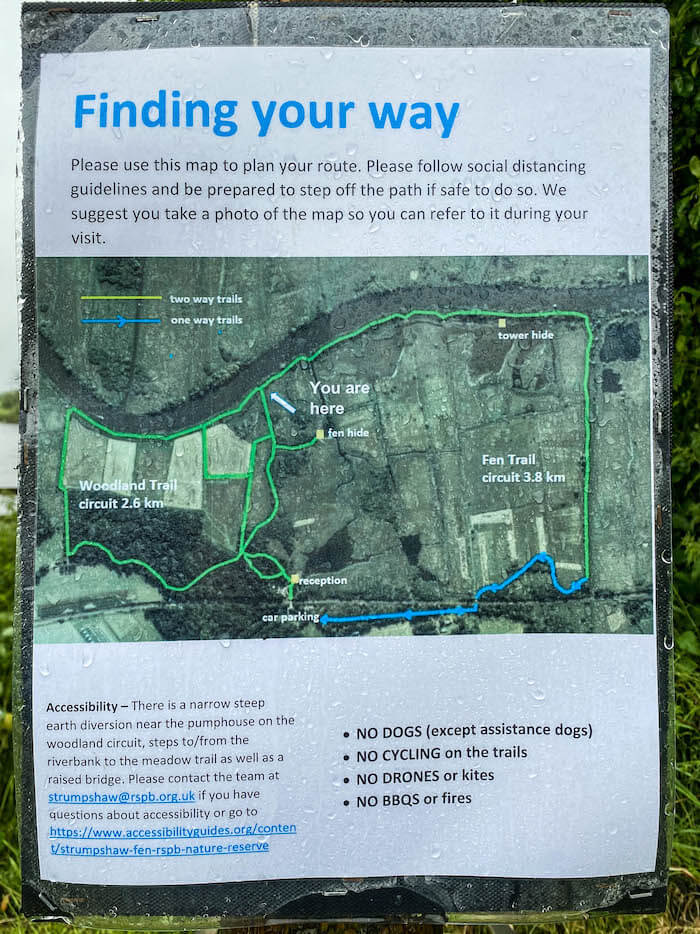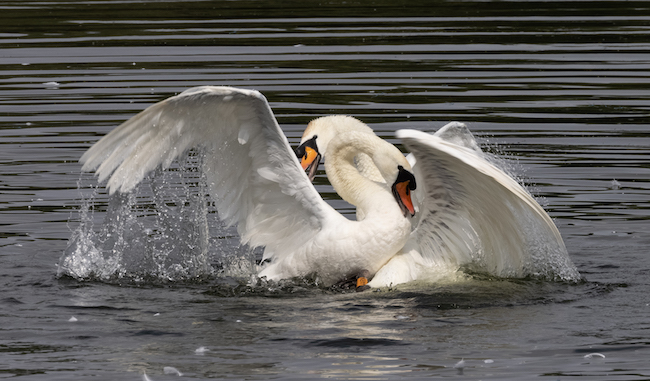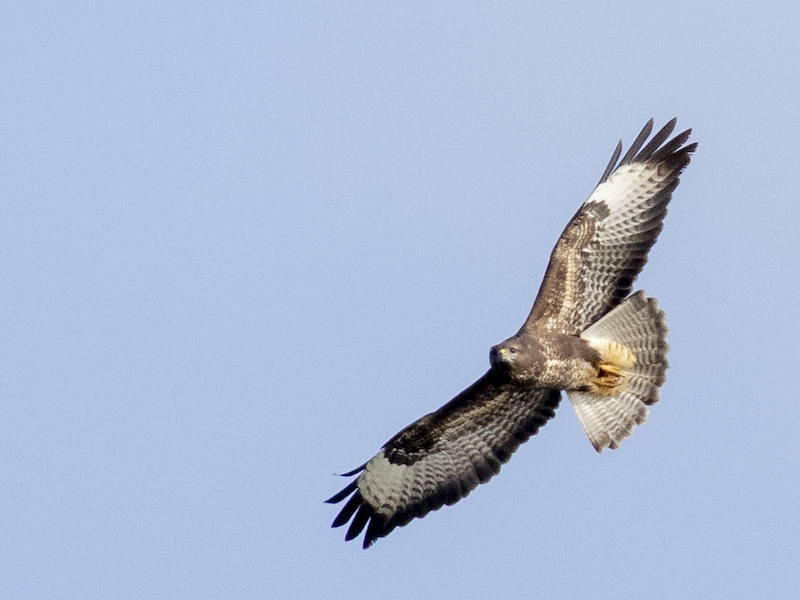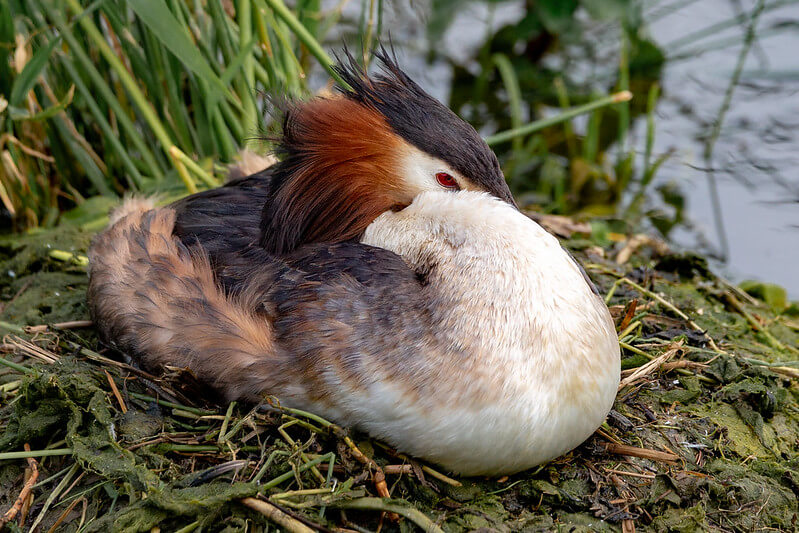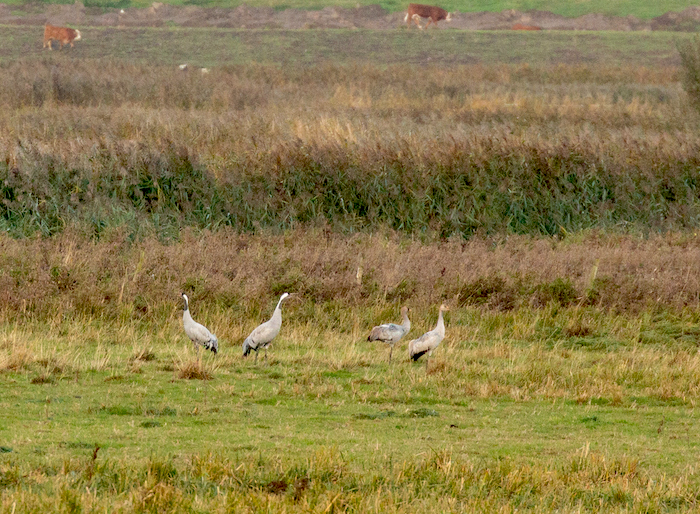- Home
- Wildlife in the UK
- Mute Swans
Your Full Guide to the Mute Swan
From childhood memories of feeding swans to nerve-wracking encounters as a photographer, Mute Swans have always fascinated me.
They are a beloved part of the British countryside, yet often misunderstood regarding their temperament. Is their protective nature something to fear?
This comprehensive guide explores the fascinating world of these iconic birds. Whether you're a keen birdwatcher, photographer, or simply enjoy walks by the water, you'll find a treasure trove here. We'll look at:
- How to identify Mute Swans and understand their true behaviour.
- Surprising facts about their lifecycle, diet, and family bonds.
- The challenges they face and important conservation insights.
- Practical tips for photographing their stunning white plumage effectively.
Join me as we uncover the reality behind the elegance of the Mute Swan.
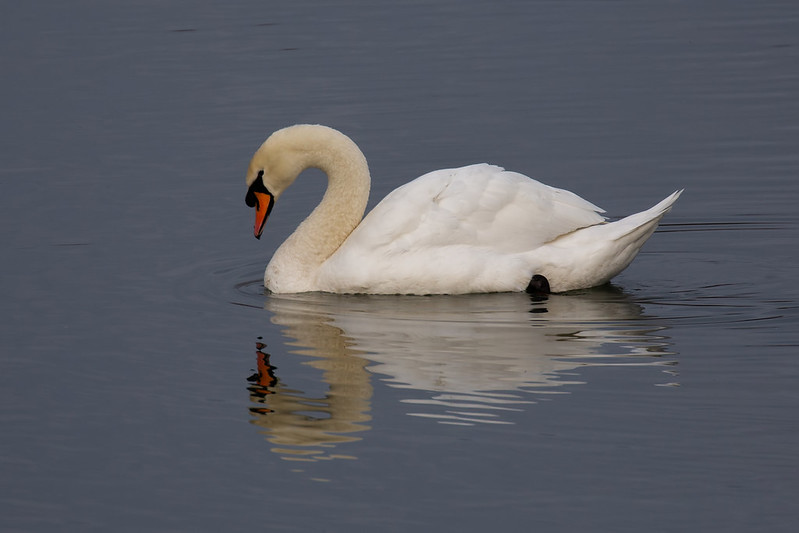 The iconic elegance of a Mute Swan perfectly reflected on calm water.
The iconic elegance of a Mute Swan perfectly reflected on calm water.Perhaps the most common question surrounding these powerful birds relates to their temperament – are they truly aggressive, and should we be wary around them? Let's start by exploring their behaviour.
Understanding Mute Swan Behaviour
When you think of potentially hazardous wildlife in the English countryside, mute swans might not immediately spring to mind. However, these elegant birds can be surprisingly territorial, especially when protecting their young.
On land, Mute Swans value their space, especially when protecting nests or young.
If you encounter one, give it a wide berth (think several metres if possible). Avoid staring directly at it, as sustained eye contact can be perceived as a challenge. If you accidentally get too close, it's best to back away slowly and calmly.
My husband and I had a close encounter with one at Summer Leys Nature Reserve in Northamptonshire, as shown in the photo below. We decided against visiting the hide that it was defending!
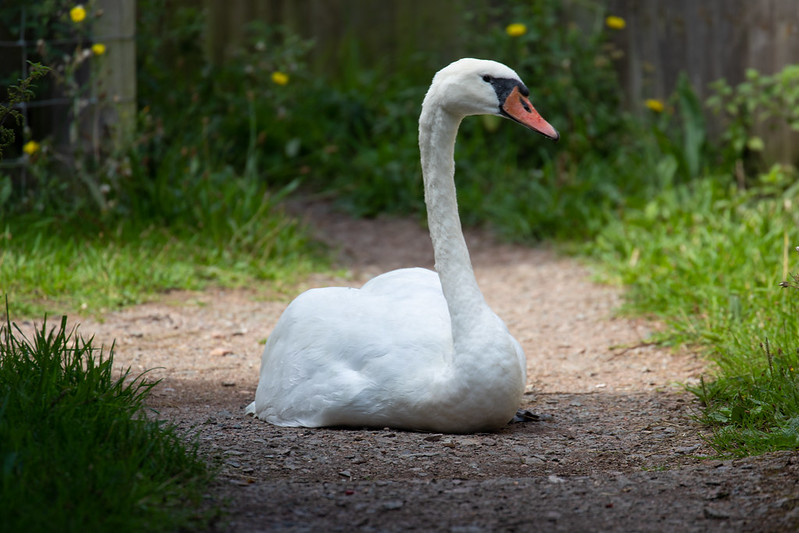 "You shall not pass!" This Mute Swan's defensive posture near the hide at Summer Leys made us decide on a different route.
"You shall not pass!" This Mute Swan's defensive posture near the hide at Summer Leys made us decide on a different route.While an altercation might be intimidating, it's unlikely to result in severe physical harm.
Contrary to popular belief, swans' wings are not robust enough to break a human's arm. However, if you injure the bird while defending yourself, you could face legal consequences under the Wildlife and Countryside Act of 1981.
This protective nature is no accident; it's rooted in the powerful family bonds Mute Swans form. They typically pair for life and are fiercely protective of their partner and young.
The male, or cob, takes his role as guardian seriously, charging at other birds and hissing, with wings half-raised in an intimidating display. Understanding their behavior can help you respect their space and enjoy their beauty from a safe distance.
This principle of understanding and respecting space extends to all wildlife, of course. Remember, every creature has its own unique defence mechanisms and behaviours.
By approaching all wildlife with respect and understanding, we can coexist peacefully and appreciate the natural world around us.
Take a closer look at the raw intensity of nature with our page on a battle between male mute swans.
How can you recognize a mute swan?
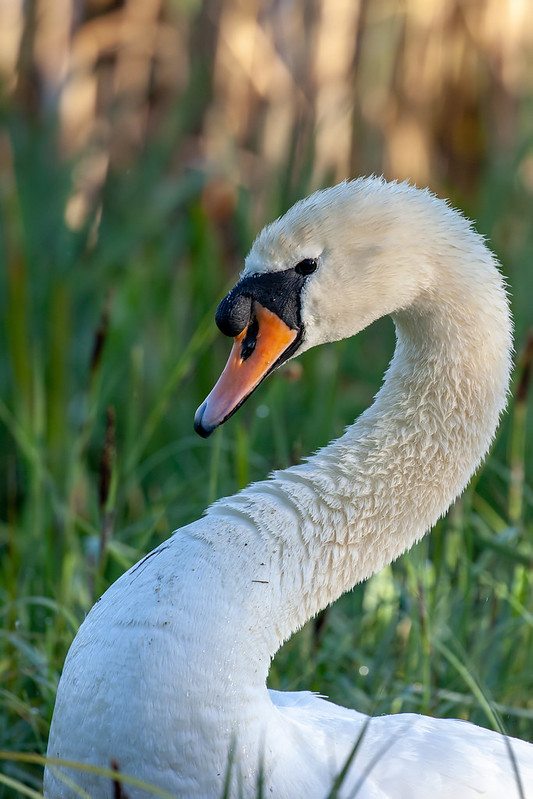 The orange beak and curved neck of an adult mute swan
The orange beak and curved neck of an adult mute swanMute Swans (Cygnus olor) are large, easily identified waterfowl found across the UK.
The main features of the adults include their brilliant white plumage, a distinctive orange beak with a black tip (males also have a prominent black knob at the base), and black legs and feet. Their gracefully curved necks and rounded heads also help distinguish them from other swan species present during winter.
Are mute swans really mute?
Despite their name, Mute Swans aren't entirely silent, though they are less vocal than other swan species.
You'll mainly hear adults making sharp hissing sounds defensively at intruders, or young cygnets letting out soft peeping calls to stay in contact with the family group.
The most distinctive sound associated with Mute Swans, however, isn't a vocalisation at all – it's the powerful 'whoomp whoomp' of their wings in flight.
As large, heavy birds with wingspans reaching up to 2.5 metres, takeoff requires considerable effort. They often run across the water's surface, wings beating laboriously against the air, generating that unmistakable throbbing sound, especially as they climb.
This wing noise is often the primary way you'll 'hear' a Mute Swan flying overhead, unlike the loud honking calls made by migrating Whooper Swans (as you can hear in the video below from the Ouse Washes).

The breeding season
Witnessing the start of the Mute Swan breeding season, usually around March or April, is always a special part of the spring.
These swans typically don't breed until they're about four years old, and once paired (often for life!), their dedication is remarkable.
It's fascinating to watch them construct their huge nest mound – often reusing a previous year's site near the water's edge. The male (cob) might bring reeds and vegetation, but it's usually the female (pen) who meticulously arranges it all.
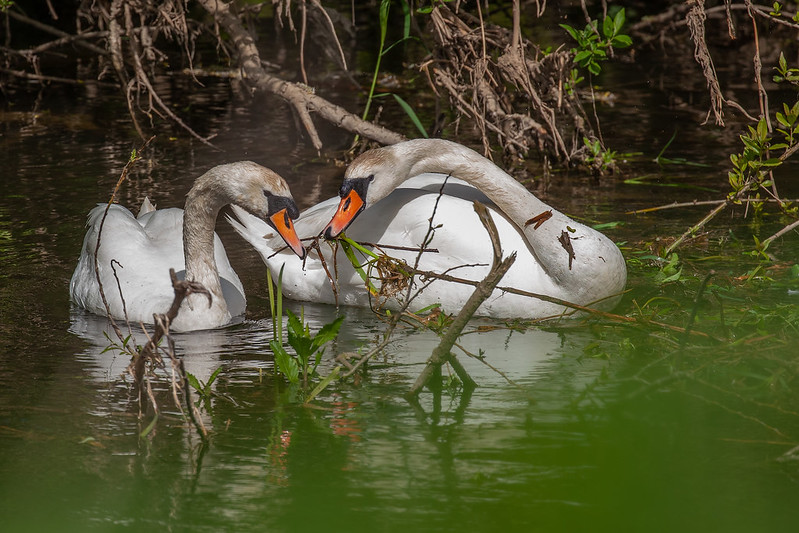 Courting behaviour on the river at Thrapston, Northamptonshire
Courting behaviour on the river at Thrapston, NorthamptonshireShe'll then settle down to lay her clutch, typically up to 7 eggs (though sometimes more!), laying one every other day before starting the long incubation period which lasts around 35-41 days.
While the pen incubates, the cob is never far away, vigilantly guarding their territory. This is when their protective instincts are highest.
While their conservation status is 'least concern', UK wildlife law protects them from disturbance while nesting, so using a long lens from a significant distance is essential – just as I did for the photo below, taken ethically at Barnwell Country Park.
Approaching too closely can cause distress and endanger the nesting attempt.
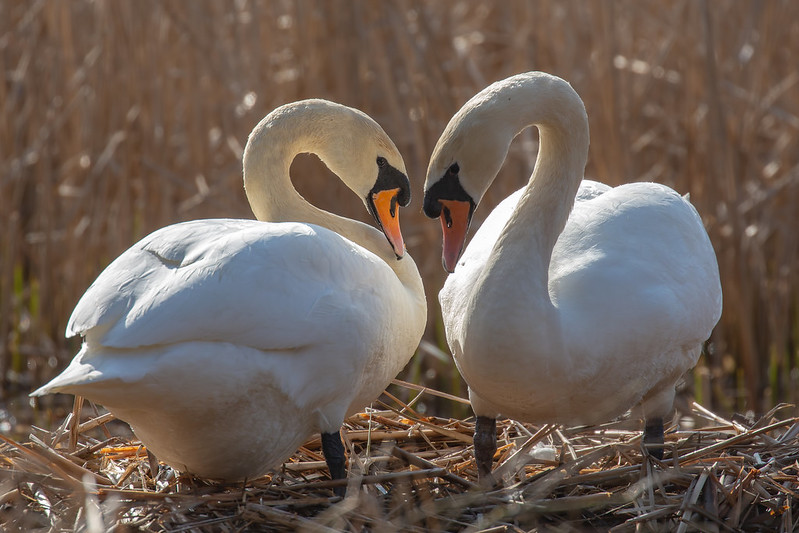 Building the nest at the edge of the lake
Building the nest at the edge of the lakeOnce the cygnets hatch (usually all within about 24 hours!), watching the family is a true delight.
They start as tiny balls of pale grey down, looking quite different from their elegant parents. It's wonderful to track their progress over the next few months as they transform through that brownish, fluffy 'ugly duckling' stage before finally gaining their white adult plumage around a year later.
Their beaks undergo a similar change, starting dark grey, becoming pinkish, and eventually developing that signature adult orange.
Documenting these stages is a rewarding long-term project for any wildlife photographer!
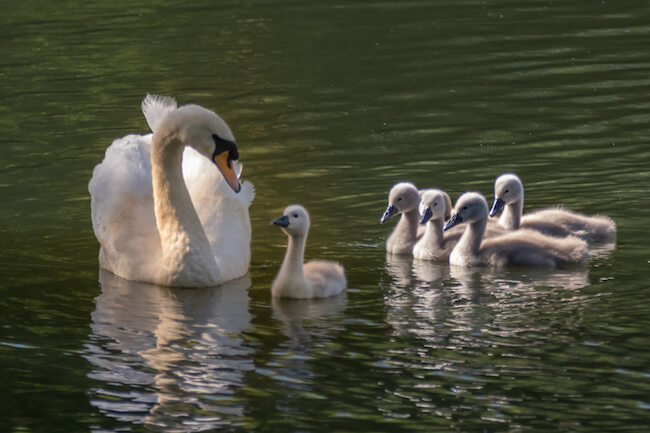 An attentive Mute Swan parent guiding five young cygnets across the water.
An attentive Mute Swan parent guiding five young cygnets across the water.The parents are incredibly attentive, teaching the cygnets essential skills like foraging – pulling up weeds or stirring up sediment for them.
One of the most endearing sights, which always brings a smile to my face, is seeing tiny cygnets hitching a ride on a parent's back, nestled safely in the feathers to rest or keep warm.
This close family unit lasts for about four to five months. By their first winter, you might witness the seemingly harsh behaviour of the parents driving the now large juveniles away.
It looks tough, but it's a vital push towards independence before the next breeding cycle begins.
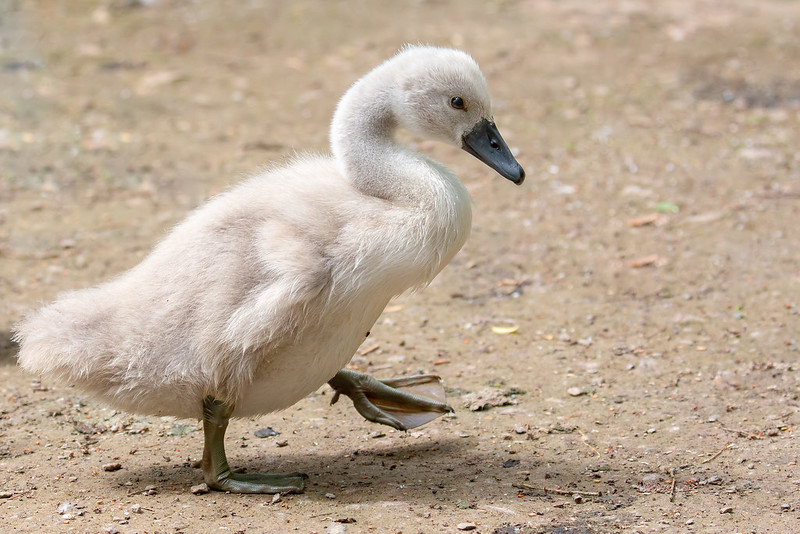 A cygnet crossing the path in front of me
A cygnet crossing the path in front of meLifespan and Threats
An adult Mute Swan typically has a lifespan of around 10 years in the wild, though ringed individuals have shown they can live much longer – one reached 15, and there are reports of swans living up to 28 years!
Discovering the age is possible if a swan has been ringed, usually as a cygnet, as the ring details its origin and year. However, achieving such longevity faces numerous challenges in the modern world.
While natural predators like foxes exist, and off-lead dogs can pose a risk, sadly, the greatest dangers Mute Swans face today often stem from human activity. These include:
- Accidental electrocution from power lines and pylons located along flight paths
- Entanglement in, or ingestion of, discarded fishing tackle.
- Lead poisoning from weights (though thankfully much reduced since the 1987 ban on lead fishing weights).
- Collisions with vehicles when mistaking wet roads for waterways.
- Water pollution impacting both the swans and their food sources.
- Deliberate vandalism or cruelty, which remains a sad reality and a punishable crime under wildlife laws.
Habitat and Distribution
Mute Swans are widespread across the UK, though numbers are generally higher in England and Ireland compared to Scotland and Wales.
You'll typically find these adaptable birds on lowland freshwater habitats like lakes, ponds, reservoirs, slow-flowing rivers, and canals. They aren't confined to water, however, and often graze on nearby grassy fields or arable land.
While breeding pairs are famously territorial, Mute Swans can become more sociable outside the breeding season, especially during their annual moult. Usually occurring in late summer, this six-week period sees them replace their flight feathers, rendering them temporarily flightless and vulnerable.
For safety during this flightless period, and often through the winter seeking food sources, Mute Swans may gather in large flocks, sometimes forming substantial colonies.
Notable examples where you can witness these gatherings include the winter feeding spectacle at the Welney Wildlife and Wetlands Trust in Norfolk, the famous swannery at Abbotsbury in Dorset, and large non-breeding flocks found at places like Berwick-upon-Tweed.
Diet and Feeding Considerations
Mute Swans are primarily herbivores with a large appetite, sometimes consuming several kilograms of vegetation daily!
Their main natural food source consists of a variety of submerged aquatic plants.
Using their long necks expertly, they reach down to graze on pondweeds, stoneworts, eelgrass, algae, and other vegetation, often 'upending' (tilting forward with tail in the air) a technique also common among many species of UK ducks lto access deeper plants, roots, and tubers.
They aren't strictly limited to underwater fare.
You'll frequently see Mute Swans grazing on short grass on riverbanks or in nearby fields, especially in winter.
While mainly plant-eaters, they also incidentally consume small insects, snails, tadpoles, and occasionally tiny fish caught amongst the vegetation. Spilled grain in agricultural fields is also readily eaten.
Given their visibility, the question of supplementary feeding by humans often arises, particularly concerning bread.
While a varied natural diet is undoubtedly best, the current advice from many UK wildlife organisations is that feeding bread in moderation isn't inherently harmful (though mouldy bread absolutely is!).
White bread offers little nutritional value compared to wholemeal. However, large quantities of any bread can lead to dietary issues and is discouraged. If you wish to offer food, much healthier alternatives include:
- Specific floating swan & duck pellets (available from pet stores/online)
- Grains like wheat or corn
- Uncooked porridge oats
- Defrosted peas or sweetcornChopped leafy greens (like romaine lettuce, spinach, cabbage - avoid iceberg lettuce which has little nutritional value)
(Remember to always throw food into the water rather than encouraging swans onto land to feed, as this can put them at risk from dogs or traffic).
It's also important to clarify the issue of 'angel wing'.
This developmental condition, where a cygnet's wing joint twists outwards preventing flight, has often been incorrectly blamed solely on bread.
While the exact causes are debated, experts generally believe it's linked to an unnaturally high-protein or high-carbohydrate diet during critical growth phases, leading to overly rapid wing development that the joint can't support.
Genetics may also play a role. Providing cygnets access to a balanced, natural diet is the best prevention.
While we've discussed feeding swans as members of the public, their relationship with humans has a much longer and more formal history in the UK, particularly concerning ownership by the Crown. This historic status gives rise to the unique practice of Swan Upping.
The Royal Tradition of Swan upping
Swan upping is a tradition that dates back to medieval times, when nobles would mark their swans as a sign of ownership. They often served them at banquets and considered them an important food source!
Today, this practice has evolved into an annual event on the River Thames that serves as a health check for these regal birds.
The Kings Swan Marker has the job of counting the cygnets, as well as weighing and measuring them while checking for signs of disease.
They are then ringed by the King's Swan Warden.
This unique royal tradition underscores the Mute Swan's iconic status and enduring appeal in British culture.
It's no surprise, then, that so many of us feel compelled to capture their elegance on camera when we encounter them. Getting truly great swan photos, however, involves overcoming a few common challenges
Tips for Photographing Mute Swans
There seems to be an irresistible urge for many to photograph swans when they see them.
After all who can resist their beauty?
However, it can be more tricky than you might think to get great photos of swans. There are three main problems...
- Most people will stand upright and photograph them from above, which distorts the perspective, making them appear to have large heads and tiny bodies.
- That white body! Get the exposure wrong and all you get is a pure white overexposed blob with no detail.
- Many people only bring out the camera when the sun is shining. This can cause harsh shadows, especially on a white bird, which can spoil your photos.
If it is safe to do so, try to get down lower so your eye line is level with theirs, to get better photos.
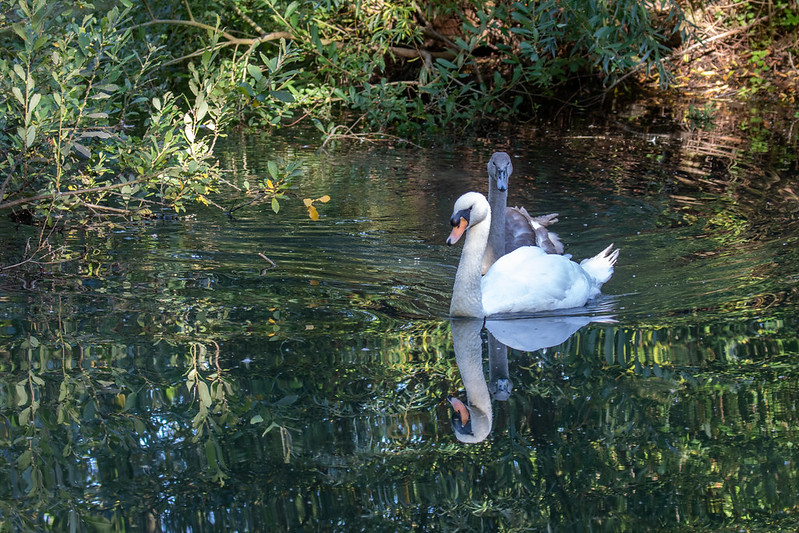 The camera overexposed the white bird
The camera overexposed the white birdIf you include plenty of background, your camera's automatic exposure will cope well. This is because there is a balance of bright and darker elements within the frame.
But move in closer and all it will see is the white and it will compensate for this by darkening the picture.
This is because the sensor turns everything in the frame to a neutral 50% grey tone and exposes for that, resulting in a dirty-looking subject.
If your camera settings are adjustable, try dialing in a little negative exposure compensation to correct this. You should then end up with a bird that retains some detail in the white feathers.
To avoid harsh shadows try taking your pictures earlier or later in the day. The sun won't be overhead and shadows will be softer.
Or go out on an overcast or misty day for really atmospheric shots. I took the following photograph early on a very misty day, and it oozes atmosphere.
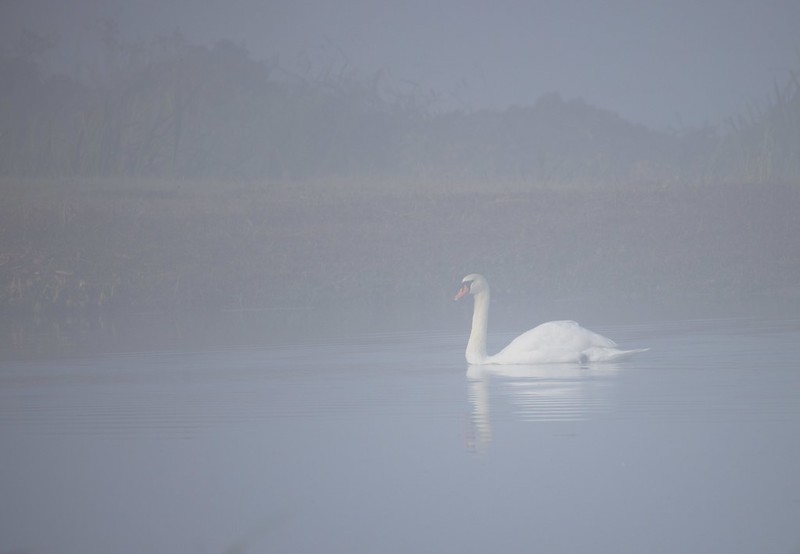 Shooting on overcast or misty mornings can create wonderfully atmospheric swan photos like this one.
Shooting on overcast or misty mornings can create wonderfully atmospheric swan photos like this one.Capturing atmospheric photos like these is certainly rewarding.
Ensuring you've correctly identified your subject is also important, especially as the familiar Mute Swan isn't the only swan species you might encounter on UK waters.
Comparing UK Swan Species
Indeed, while Mute Swans grace our waters year-round, two other species – the Whooper and Bewick's Swans – are primarily winter visitors migrating here from colder regions. Here's how to tell them apart from the Mute Swan and each other:
The Whooper Swan (Cygnus cygnus), a winter visitor from Iceland, is similar in size to the Mute Swan.
However, key differences are immediately apparent: unlike the Mute's familiar S-curve neck and orange bill, the Whooper holds its neck much straighter and boasts a distinctive, wedge-shaped yellow bill with a black tip. The pointed 'V' of yellow extends quite far down the bill.
Whoopers are also known for being much more vocal than Mutes, often 'whooping' in flight.
Occasionally, individuals get left behind, like an injured Whooper I saw one summer at Frampton Marsh, Lincolnshire, patiently waiting alone until the flocks returned in Autumn.
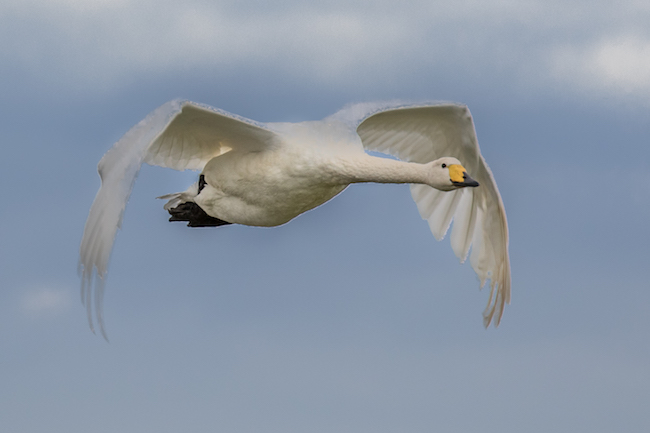 The Whooper Swan in flight – note the straight neck and bill shape.
The Whooper Swan in flight – note the straight neck and bill shape.The Bewick's Swan (Cygnus columbianus bewickii), migrating from Arctic Russia, is noticeably smaller than both the Mute and Whooper Swan.
Like the Whooper, it holds its neck straight, differentiating it from the Mute Swan.
Its bill pattern is the key identifier compared to the Whooper: the yellow patch on the black bill is more rounded or oval-shaped and typically covers less than half of the bill (lacking the Whooper's long yellow wedge).
Sadly, Bewick's Swan numbers have declined significantly in recent years, placing them on the UK's Red List for birds.
Although not native nor a migrant, you may see Black Swans in Dawlish, Devon. This town is famous for these birds which have been there since the early 1900s.
Although wild, the Dawlish Town Council manages them, along with other waterfowl.
Black swan cygnets remind me of the fairy tale ugly duckling, with their fuzzy grey feathers! The young swans do not have the striking red beak with a white stripe that their parents sport.
I have seen all but Bewick's in the wild, and it is always a special experience. If you get the chance to see any of these graceful creatures, take it! You won’t be disappointed.
 The non-native Black Swan, famous resident of Dawlish, Devon, is easily identified by its dark plumage and bright red bill.
The non-native Black Swan, famous resident of Dawlish, Devon, is easily identified by its dark plumage and bright red bill.If learning about Mute Swan behaviour has particularly intrigued you, don't miss the dramatic photo sequence of a Mute Swan attack I captured.
Or, to discover great locations for spotting swans and other birds, explore my guides to nature walks in Cambridgeshire or get broader tips on identifying wild birds.

About the Author
Carol is a wildlife photographer and nature writer based in the East of England, with a passion for peaceful walks, patient observation, and capturing life’s quiet wonders.
Through her lens and words, she shares the stories of the natural world — from bluebells and butterflies to birds like the great crested grebe.
Get closer to UK nature
Subscribe to Wild Lens!
Want to discover more hidden walks and wildlife moments?
I’d love to share my latest nature finds, photo tips, and peaceful walk recommendations with you.
💌 Join my newsletter Wild Lens—it’s free, occasional, and always rooted in a love of the natural world.
Subscribe below and come exploring with me.
